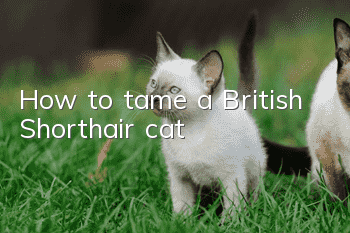How to tame a British Shorthair cat

The British Shorthair cat, referred to as British Shorthair, can be said to be one of the most popular pets. In the process of raising cats, we will always tame them, so let’s find out how to tame them.
Short-haired cat
Maintenance 1. Feeding: Changes in the amount of exercise will cause changes in the digestion and absorption capacity of the intestines and the filtration and detoxification functions of the liver and kidneys. Pay more attention to the hardness of food suitable for cats, supplement calcium, iron, vitamins and other trace elements in appropriate amounts, and change to different flavors. food; (Note: fast food that is not easy to digest and ensure a supply of clean water)
2. Brush your pet’s teeth: If possible, brush your pet’s teeth to reduce the invasion of bacteria caused by gum inflammation;
3. Eye care: Frequently use wet cotton to remove excess mucus and clean the skin around the eyes;
4. Ear care: Check the inner auditory canal regularly;
5. Joint care: Joint pain is a common problem in elderly pets. If it cannot move regularly, you can gently massage its muscles or move its limb joints while it is resting.
Cat claws are tools used by cats to catch mice, climb and defend themselves. If the owner keeps a cat to hunt mice, of course, the claws cannot be trimmed. If the owner keeps a cat as a companion animal, the cat's claws should be trimmed regularly to avoid scratching people and damaging clothes, furniture, floors, etc. Claws should be trimmed from an early age, once a month or so. The specific method is as follows: Hold the British shorthair cat in your arms, grab one of the cat's feet with your left hand, and squeeze it slightly with your thumb, index finger, and middle finger to extend the paw. Then hold the nail clipper with your right hand, carefully cut off the transparent part of the front end of the claw, and then use the small file on the nail clipper to polish the claw.
When trimming, do not cut too much to avoid hurting the British Shorthair cat’s feet. Then cut off and polish the other claws in turn. Bathing a British shorthair cat can not only keep the cat clean and beautiful, but it can also remove some parasites on the body surface, promote blood circulation and metabolism, and play a role in disease prevention and fitness.
It is best to cultivate the habit of bathing from an early age. Cats will be extremely reluctant to bathe their cats until they are adults. Before taking a bath, you should prepare bathing utensils, such as bathtub, bath towel, detergent, comb (preferably sparse at one end and dense at the other), brush, etc.
When taking a bath, the water temperature should not be too low or too high, so as not to scald your hands; the detergent used should not be too irritating to avoid irritating the skin; British short-haired cats should treat their coat before taking a bath. Comb the hair to prevent it from getting tangled; bathe quickly and finish washing in as short a time as possible; after washing, dry the hair with a bath towel immediately. When the temperature is low, it is best to cover it with a special towel or other warm products , to prevent colds.
The tongue of British shorthair cats is rough and has special barbed tongue papillae, which is like a comb. British shorthair cats often use tongue licking to comb their coat.
Use paws to comb the parts that cannot be licked, such as the head, shoulders, back, neck, etc. Even so, it's best to groom your cat once a day. Because cats are available all year roundAll cats will shed their hair, especially during the shedding season of spring and autumn. Cats grooming themselves will swallow the hair into the stomach, and over time, hair balls will form in the stomach. If they cannot be vomited out, and cannot be excreted through the intestines in time, they will remain in the stomach. Inside, hair balls will become clogged, affecting appetite and even life-threatening.
When combing, not only comb along the hair, but also against the hair. When combing British short-haired cats, you can first wet the hair with water and then rub it to make the coat stand up for easy combing.
If the British shorthair cat's coat becomes tangled or stuck together, you can use your fingertips to untangle it, or use a sparse-toothed comb to comb it slowly and carefully. If the felt has been rolled, you can use scissors to cut the felt into thin strips along the growth direction of the hair, and then comb it with a comb. If the felting is severe, the coat can be cut off to allow it to grow again. Healthy British shorthair cats have bright and energetic eyes. When British shorthair cats are sick or in poor health, they are often afraid of light and shed tears.
In some cat breeds, the nasolacrimal ducts are easily blocked and cause tears. Cats shed excessive tears and often have eye feces in the corners of their noses. You can use absorbent cotton dipped in 2% boric acid aqueous solution and gently scrub it away. British shorthair cat ear care mainly involves removing earwax.
The method is: use 75% alcohol cotton balls to disinfect the external auditory canal, then dip the cotton swab in olive oil or edible vegetable oil to soak the dry earwax. After it softens, use tweezers to carefully remove the earwax. , do not break the mucous membrane of the ear canal to prevent infection and suppuration. Once the cat's external auditory canal is infected and suppurative, you can use a cotton swab dipped in hydrogen peroxide to scrub gently, and scrub repeatedly until there is no trace of pus on the cotton swab, and then use absorbent cotton to absorb the hydrogen peroxide in the ear canal. The infection can be cured with a few scrubs. If the cat has too much earwax and the cat shakes its head and scratches its ears, it should be consulted by a veterinarian in time.
- Can human eye drops be used on cats?
- Symptoms and prevention methods of urinary stones in cats
- What should I do if my cat keeps eating but doesn’t gain weight? How to gain weight for cats!
- What are the symptoms before a cat gives birth to kittens?
- Popular science about cat vaccinations, which brand of vaccine is good?
- How to deal with a bitten cat
- How many months does it take for a kitten's personality to stabilize?
- Can nursing cats be dewormed?
- Why does a cat bite its tongue?
- What are the signs that a cat lacks love?



